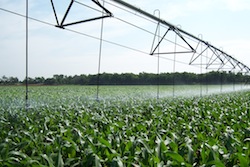According to a new study by Rice University and the University of California at Davis, if the climate continues to evolve as predicted by the Intergovernmental Panel on Climate Change, the U.S. stands little to no chance of satisfying its current  biofuels goals. The study, published in journal Environmental Science and Technology suggests that in 40 years, a hotter planet would cut the yield of corn grown for ethanol by an average of seven percent while simultaneously increasing the amount of irrigation necessary by nine percent.
biofuels goals. The study, published in journal Environmental Science and Technology suggests that in 40 years, a hotter planet would cut the yield of corn grown for ethanol by an average of seven percent while simultaneously increasing the amount of irrigation necessary by nine percent.
Principal investigator Pedro Alvarez, the George R. Brown Professor and Chair of Rice’s Civil and Environmental Engineering Department, said that this could sharply hinder a mandate as being executed by the Renewable Fuel Standard (RFS) that mandates 15 billion gallons of ethanol (corn) per year by 2022. The policy, Alvarez explained, is based on the idea that blending ethanol reduces harmful tailpipe emissions, but the cost in water may outweigh these concerns.
“Whereas biofuels offer a means to use more renewable energy while decreasing reliance on imported oil, it is important to recognize the tradeoffs,” Alvarez said. “One important unintended consequence may be the aggravation of water scarcity by increased irrigation in some regions.”
The authors of the new paper have long questioned the United States’ support of biofuels as a means to cut vehicle emissions. In a 2010 white paper on U.S. biofuels, the authors found “no scientific consensus on the climate-friendly nature of U.S.-produced corn-based ethanol” and detailed what they saw as economic, environmental and logistical shortcomings in the renewable fuels policy and suggested a need for further study of water impacts.
In the most recent study, the team built computer simulations based on crop data from the nation’s top 10 corn-producing states – Iowa, Illinois, Nebraska, Minnesota, Indiana, Ohio, South Dakota, Wisconsin, Missouri and Kansas. They also used estimates of carbon dioxide, a greenhouse gas, and other elements from a number of models, including the government’s well-tested Environmental Policy Integrated Climate (EPIC) model. They used the simulation to predict crop outcomes over the next 40 years in relation to expectations of climate change.
The researchers found states in the Corn Belt (Iowa, Illinois, Indiana, Ohio and Missouri) and the Great Lakes (Minnesota and Wisconsin), where corn growth is primarily fed by rainfall, would be subject to more intense but less frequent precipitation, especially during the summer. Maintaining crops would require a 5 to 25 percent increase in irrigation, which would in turn require more extensive – and expensive – water catchment infrastructure.
On the Northern Plains of South Dakota, Nebraska and Kansas, where the growth of corn for ethanol already depends heavily on irrigation, the study found that crop yields would decline even if irrigation continued to be “applied as needed,” the researchers wrote. In fact, the 2012 drought has already damaged Great Plains farmlands where long-reliable aquifers  used for irrigation are beginning to run dry.
used for irrigation are beginning to run dry.
The researchers said agriculture costs the water supply in two ways: through the drawdown of groundwater from irrigation and through loss to the atmosphere via evapotranspiration (ET), by which water moves through plants and evaporates. Higher atmospheric temperatures increase ET at a cost to groundwater, they wrote.
The production of one liter of gasoline requires three liters of water, according to the researchers. The production of one liter of corn ethanol requires between 350 and 1,400 liters of water from irrigation, depending on location. A liter of ethanol also translates into 1,600 liters of ET water that might not directly replenish the local watershed.
The researchers suggested the growth of crops for ethanol was already questionable because of its impact on the environment. Rising temperatures in the decades to come, they wrote, could lead to reductions in crop yields and an increase in irrigation demands to the degree that the government mandate is no longer economically viable.
“The projected increases in water intensity due to climate change highlight the need to re-evaluate the corn ethanol elements of the Renewable Fuel Standard,” Dominguez-Faus said, lead author of the paper.

